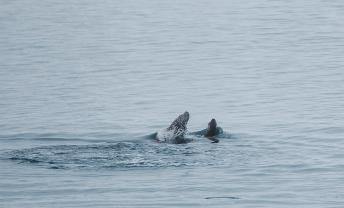|
Click on the question mark to ask the class about oceanography, Glacier Bay, or the cruise. Your question and answer will appear on the Questions page under Quick Links. |

|
11:30 AM One of the readers of this blog submitted a question several days ago. This question was fundamental enough to warrant a more in-depth response than room allowed on the Questions and Answers page. The question was what is special about Glacier Bay to allow it the distinction of being one of the richest cold water ecosystems in the world? And further, what's different about it from many other cold-water bays? To this question I would add two more; given the lack of baseline data how can we tell if human actions are currently changing the Bay? Is it serving as a successful model for marine park management at a time where the vast majority of marine coastal areas are under stress?
Fortunately we had along on this cruise Leuis Sharman, a marine ecologist with Glacier Bay National Park. I had the opportunity to pose these questions to Leuis, and engage him in some discussion on these issues.
Let’s start with a little background on the Bay and Park. Glacier Bay is first and foremost a marine park. There are approximately 15 miles of road surrounding the NPS headquarters and nearby town of Gustavus. No outside roads connect to the park. Virtually all visitors to the park come by boat (perhaps 10% come by plane via Gustavus). The vast majority of these visitors come aboard cruise ships which hold as many as 3,000 passengers. These visitors get to experience the beauty of the park without ever setting foot on the land in it. The remaining visitors come by small boat; tour boats, charter boats, and private boats. Most of these visitors will follow the same itinerary as the cruise ships; observing the main attractions of the Park from a distance and retreating. A very small minority will opt for a more intimate and prolonged encounter, hiking or sea kayaking along the coast.
What bring these visitors to the park are the spectacular glaciers and the abundance of high level predators. Most visitors probably fail to appreciate the connections between the two. It is a basic rule of ecology that predators will gather wherever prey is abundant. If orcas gather at Glacier Bay it’s because sea lions are there. The sea lions are there because large, carnivorous fish are there. We follow this pattern down the trophic levels until at the base we come upon the primary producers. On land the primary producers are grasses and other plants. The appropriate analogy would be lions on the Serengeti. Why are they there? Because there is abundant grass to support their prey.
If we take this analogy just a little further we can ask, why does so much grass grow in the Serengeti? The answer is astoundingly simple; because it’s happy there! So why do so many primary producers grow in Glacier Bay? Because they’re happy there! The main marine primary producers the world over (there are many, many significant ones with different niches, but the widely recognized “main”) are unicellular organisms known as diatoms. As the “grass” of the ocean diatoms are the base of many different ecosystems, including many supporting valuable fisheries. To understand what all this has to do with Glacier Bay and glaciers we need to understand what makes diatoms happy.
What makes diatoms happy are nutrient rich waters and lots of light. They don’t need much else. It isn’t much of a leap of logic to assume that Glacier Bay has the right amount of both. So the question really is; how does Glacier Bay’s environment provide diatoms with nutrients and light? In coastal environments nutrients are rarely a problem (often too many nutrients is the problem, as seen near the Mississippi Delta in the Gulf of Mexico). Close contact with the terrestrial environment provides ample nutrients. But what about light? As any of the students on this cruise can attest, there isn’t all that much of it in Glacier Bay. Yet even in the middle of winter productivity is known to be high.
What usually keeps diatoms happy (so long as they have nutrients) are stratified water conditions that keep them close to the light. Stratified means that the water is layered, a layer of less dense water overrides a layer of more dense water with little mixing between the two. The diatoms are able to stay suspended in the less dense layer, close to the light and with ample nutrients. This brings us full circle to glaciers. To stratify water you have to manipulate one (or both) of two parameters, salinity and temperature. Low temperatures and high salinity make water sink, high temperatures and low salinity make water rise. Glacial meltwater provides cool, but fresh water to a bay. This causes stratification and leads to happy diatoms.
So we’ve explained what about Glacier Bay might (and I emphasize that this is hypothetical though probable, the science will make its own conclusions) be cause for high productivity. But why isn’t this scenario more common, as glaciated fjords exist throughout the world? In order for diatoms to be happy year round, water has to stay stratified year round. It can mix a little, but enough mechanical energy input into the system (such as tidal action or severe storms) will result in diatoms plunging to depths from which they cannot recover. So it may be that the other key feature of Glacier Bay is relative stability in a mechanical sense. Although when the Thompson or other vessels interact with conflicting currents in the Bay it’s hard to believe, tidal energy in Glacier Bay is thought to be relatively low. Some thesis projects are working directly on the quantification of tidal energy in the Bay, so we may have some answers sooner than later.
That answers the question posed by our reader. To answer the other two questions we have to rely on the expertise of Leuis Sharman. Having traveled to a number of national parks, from the intensely wild to the intensely guard-railed, I was curious as to how Glacier Bay handles the difficult task of serving visitors and protecting the ecosystem. This, Leuis explained to me, may be a relatively easy task. As already mentioned cruise ship passengers make up the vast majority of park visitors. Although a 3,000+ person diesel-powered floating city may on the surface not seem environmentally friendly, a close look reveals a certain greenness to this kind of tourism. There is no need for roads in the park (which would be impractical anyway). No vehicles to generate gas or roadside trash. No direct impact on the ecosystem from hiking trails, bathrooms, animal-human interactions, etc. The passengers of every cruise ship can be managed by the park as a single unit, so long as an effective management plan is in place.
Glacier Bay has been exercising what they hope is an effective management plan for some time. The cruise ship industry here is carefully controlled. Restrictions on approaching marine mammals, dumping grey water (non-sewage waste water), and other practices apply to all vessels in the Park. According to Leuis the Park goes even further with cruise ships, employing an incentive system to encourage environmental innovation within the industry. The incentives are permits for cruise lines to visit the Park. Only 186 total cruise ship visits are allowed per season, and no more than two ships can visit on any single day. Permits are awarded to companies based partly on what measures they take to prevent environmental damage. The company with a cleaner burning engine for example, or a better whale avoidance protocol stands a better chance of winning permits. To insure that each ship complies with the rules of its permit the NPS places two staff members aboard every cruise ship that enters Glacier Bay National Park. Unfortunately, as with any regulatory practice there is a loophole. The NPS regulations only apply during the busy summer season. Cruise ships are increasingly crowding the “shoulder” seasons in fall and spring, when regulations don’t apply.
Of course the real problem with marine environments is that they are connected by ocean basins and currents with every other marine environment in the world. Regardless of local protection Glacier Bay National Park is threatened by the same problems that plague other ecosystems. Declining salmon stocks, ocean acidification, rising sea surface temperatures, and pollution will all play a role in the Park’s future. With luck, the data collected on this cruise and future cruises, and the Parks own internal observations will allow us to monitor and mitigate these threats.
-Jeff |
|
March 23, 2008 |


|
Byron crunches numbers aboard the Thompson. He is studying tidal energy in Glacier Bay, which may be an important factor in the ecology of the Bay. |

|
Sea lions cavort in Tarr Inlet. Next to orcas, sea lions are the top predators in Glacier Bay. |

|
Glaciers and tidal energy may be two of the key features shaping Glacier Bay’s unique ecology. |

|
The grass of the ocean. This pennate diatom was collected in a net tow from Glacier Bay. |
|
Quick Links
Senior Thesis Research Course, Ocean 444
Senior Thesis Planning Course, Ocean 443
Quick Links to Blog Entries
|
|
Glacier Bay banner background image by Andy Cameron, see original image. Send mail to: seniorcruise2008@ocean.washington.edu |